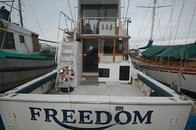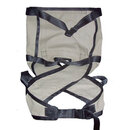Questions: :questionmark:
… Gearing up on the swim step allows us to put the gear on with them laying on a pad (never set a paralyzed diver on a hard surface to avoid pressure sores) and then rotate their feet over the edge and then roll them off the step into the water and the waiting arms of their dive buddies (HSA International certified)….
That is how they made the dive with
David Riley (quad amputee), but the boat was a Newton 42 with a huge integral swim-step and no transom above deck. If you look close you can see the transom door in photo of the Freedom (first post). We have to deal with 27" wide transom access. A ~4' deep swim-step like the Newton and removing the transom above deck would be a $tructural nightmare on the Freedom.
:questionmark:
Given the adjustable height swim step (deck to -4'), vessel layout, and sea conditions; dressing onboard and transferring seems more practical — unless we are missing something??? I personally wouldn’t want to gear-up on this boat’s swim-step in these seas.
The plan is to launch and recover the disabled diver with his buddy at the same time. The only in-water prep would be the option of latching or releasing a seat-belt. Crew can don & doff fins (from the buddy or both) while divers are seated. We figured the buddy would be first-on and off the platform.
:questionmark:
Interesting point on hard surfaces. Since divers will be in 7mm wetsuits or drysuits with insulation suitable for 50° F water, do you think that would that be enough padding?
…Only about 200 servicemen have been paralyzed in the current Iraq/Afghanistan conflict. Many more have lost limbs (usually 2 limbs or more). So the question is how many potential "customers" do you have in the area to use the boat for SCUBA in the area you would draw individuals from?….
The objective is to support all vets with difficulty diving, even if their limitations occurred as a civilian years after service or simply from age. There may even be some trips for able-bodied vets if boat time and funds are available, much like when the boat was used for sport fishing.
…Your proposals look good and you already know that working with individuals with paralysis or missing limbs in the ocean is not the same as in a hospital setting. ….
Thanks, but slowly learning is more accurate.

… Key component is of course the crew/assistants to ensure they are trained by HSA (celebrating 31 years) so they know how to move individuals without hurting themselves or the individual concerned. We learned that just moving one paralyzed individual by an untrained but well intentioned helper a few feet without dive boots on caused a sore (scrape) that in a paralyzed individual took months to heal (circulation is poor in paralyzed limbs and the healing process takes longer). So training is important.
The Gods Pocket elevator looks good.
I am working on the engineering and construction end of this program while volunteers in Monterey are managing training and support. Monterey is about 270 miles south of here and I don’t have hands-on experience or frequent face-to-face contact. I am heading down later this week and would like to have some designs worth critiquing, in addition to taking some precise dimensions to work with. Thanks for helping make me a little less ignorant for the meetings!
:questionmark:
Do you think we should put head protection on them when moved by a davit or would a 7mm hood suffice? I suppose we could go as far as a face-covered motorcycle helmet. They will still be wearing gloves at that point so the rest of their skin should be protected from abrasions. This is really the other volunteer’s area, but they may not have considered it unless they worked with a boat-mounted davit or A-frame at sea before. I am sure at-sea testing before taking disabled divers out will teach us a lot, but I would rather find mistakes now.
We had considered designs for lifting the disabled diver while strapped into the swim-step chair, or wheeling it, on and off the platform. The concept was rejected to reduce cycle time on the platform, especially on recovery operations.
:questionmark:
Do you have any thoughts on using, or sources for, lift harnesses? We are discussing a single-point lifting ring similar to
commercial diving harnesses. The D-ring would probably be on a longer strap so the snap shackle could connect above the head. We considered two shoulder D-rings but the BC or cylinder harness would interfere. Unlike a commercial diver’s harness, a true parachute-style double leg strap crotch strap should probably be used.
:questionmark:
I have been playing with seat designs. I can see a short horn, maybe 3-6" in diameter, that able-bodied divers can wrap their legs around would help stabilize them in the water. The horn would be short enough they could just stand up or swim off. Would a horn like that be in the way of a disabled diver? I was especially wondering if you strap legs together on paraplegics in dive-mode? If so, a horn would interfere. I guess it could be made retractable if the idea works in testing at all.






